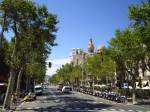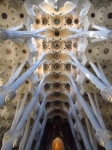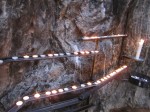 My other favourite view in Paris was from atop the Sacre Coeur. And not only was it great looking out from the roof, but looking up inside the cathedral at the painting on the interior of the roof was just stunning.
My other favourite view in Paris was from atop the Sacre Coeur. And not only was it great looking out from the roof, but looking up inside the cathedral at the painting on the interior of the roof was just stunning.
I also quite enjoyed looking down at the monastry next door, where nuns were walking around the garden in circles reading books. It was like a game of pac-man. The climb up to the roof was a bit of a mission, and not for the claustraphobic. I could imagine the majority of the All Blacks wouldn’t actually be able to fit through the narrow staircase!
The crypt underneath had some great wee treasure exhibits and chapels/sculptures too.








































































































































































































































































































